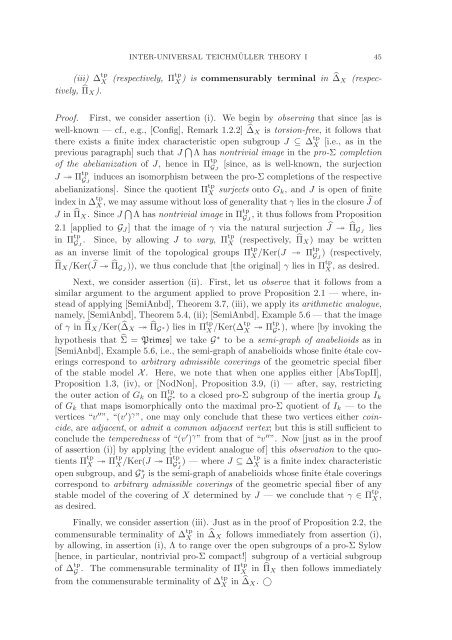Inter-universal Teichmuller Theory I: Construction of Hodge Theaters
Inter-universal Teichmuller Theory I: Construction of Hodge Theaters
Inter-universal Teichmuller Theory I: Construction of Hodge Theaters
Create successful ePaper yourself
Turn your PDF publications into a flip-book with our unique Google optimized e-Paper software.
INTER-UNIVERSAL TEICHMÜLLER THEORY I 45<br />
(iii) Δ tp X (respectively, Πtp X )iscommensurably terminal in ̂Δ X (respectively,<br />
̂Π X ).<br />
Pro<strong>of</strong>. First, we consider assertion (i). We begin by observing that since [as is<br />
well-known — cf., e.g., [Config], Remark 1.2.2] ̂Δ X is torsion-free, it follows that<br />
there exists a finite index characteristic open subgroup J ⊆ Δ tp X<br />
[i.e., as in the<br />
previous paragraph] such that J ⋂ Λhasnontrivial image in the pro-Σ completion<br />
<strong>of</strong> the abelianization <strong>of</strong> J, hence in Π tp<br />
G J<br />
[since, as is well-known, the surjection<br />
J ↠ Π tp<br />
G J<br />
induces an isomorphism between the pro-Σ completions <strong>of</strong> the respective<br />
abelianizations]. Since the quotient Π tp X<br />
surjects onto G k,andJ is open <strong>of</strong> finite<br />
index in Δ tp X<br />
, we may assume without loss <strong>of</strong> generality that γ lies in the closure Ĵ <strong>of</strong><br />
J in ̂Π X .SinceJ ⋂ Λhasnontrivial image in Π tp<br />
G J<br />
, it thus follows from Proposition<br />
2.1 [applied to G J ] that the image <strong>of</strong> γ via the natural surjection Ĵ ↠ ̂Π GJ lies<br />
in Π tp<br />
G J<br />
. Since, by allowing J to vary, Π tp X (respectively, ̂ΠX ) may be written<br />
as an inverse limit <strong>of</strong> the topological groups Π tp X<br />
/Ker(J ↠ Πtp<br />
G J<br />
) (respectively,<br />
̂Π X /Ker(Ĵ ↠ ̂Π GJ )), we thus conclude that [the original] γ lies in Π tp X<br />
, as desired.<br />
Next, we consider assertion (ii). First, let us observe that it follows from a<br />
similar argument to the argument applied to prove Proposition 2.1 — where, instead<br />
<strong>of</strong> applying [SemiAnbd], Theorem 3.7, (iii), we apply its arithmetic analogue,<br />
namely, [SemiAnbd], Theorem 5.4, (ii); [SemiAnbd], Example 5.6 — that the image<br />
<strong>of</strong> γ in ̂Π X /Ker( ̂Δ X ↠ ̂Π G ∗) lies in Π tp X /Ker(Δtp X ↠ Πtp G<br />
), where [by invoking the<br />
∗<br />
hypothesis that ̂Σ =Primes] we take G ∗ to be a semi-graph <strong>of</strong> anabelioids as in<br />
[SemiAnbd], Example 5.6, i.e., the semi-graph <strong>of</strong> anabelioids whose finite étale coverings<br />
correspond to arbitrary admissible coverings <strong>of</strong> the geometric special fiber<br />
<strong>of</strong> the stable model X . Here, we note that when one applies either [AbsTopII],<br />
Proposition 1.3, (iv), or [NodNon], Proposition 3.9, (i) — after, say, restricting<br />
the outer action <strong>of</strong> G k on Π tp<br />
G<br />
to a closed pro-Σ subgroup <strong>of</strong> the inertia group I ∗<br />
k<br />
<strong>of</strong> G k that maps isomorphically onto the maximal pro-Σ quotient <strong>of</strong> I k —tothe<br />
vertices “v ′′ ”, “(v ′ ) γ ”, one may only conclude that these two vertices either coincide,<br />
areadjacent, oradmit a common adjacent vertex; but this is still sufficient to<br />
conclude the temperedness <strong>of</strong> “(v ′ ) γ ”fromthat<strong>of</strong>“v ′′ ”. Now [just as in the pro<strong>of</strong><br />
<strong>of</strong> assertion (i)] by applying [the evident analogue <strong>of</strong>] this observation to the quotients<br />
Π tp X ↠ Πtp X<br />
/Ker(J ↠ Πtp<br />
G<br />
)—whereJ ⊆ Δ tp ∗ X<br />
is a finite index characteristic<br />
J<br />
open subgroup, and GJ ∗ is the semi-graph <strong>of</strong> anabelioids whose finite étale coverings<br />
correspond to arbitrary admissible coverings <strong>of</strong> the geometric special fiber <strong>of</strong> any<br />
stable model <strong>of</strong> the covering <strong>of</strong> X determined by J — we conclude that γ ∈ Π tp X ,<br />
as desired.<br />
Finally, we consider assertion (iii). Just as in the pro<strong>of</strong> <strong>of</strong> Proposition 2.2, the<br />
commensurable terminality <strong>of</strong> Δ tp X<br />
in ̂Δ X follows immediately from assertion (i),<br />
by allowing, in assertion (i), Λ to range over the open subgroups <strong>of</strong> a pro-Σ Sylow<br />
[hence, in particular, nontrivial pro-Σ compact!] subgroup <strong>of</strong> a verticial subgroup<br />
<strong>of</strong> Δ tp<br />
G . The commensurable terminality <strong>of</strong> Πtp X in ̂Π X then follows immediately<br />
from the commensurable terminality <strong>of</strong> Δ tp X in ̂Δ X . ○
















